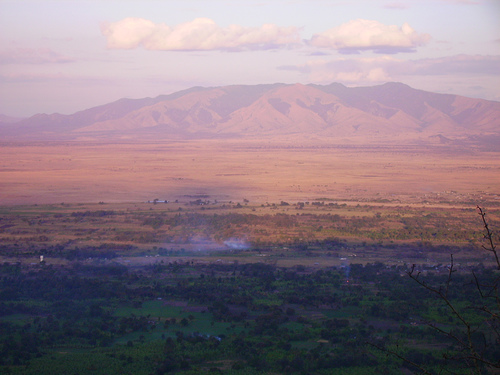

Location: Arusha Region Map
Area: 325 km²
Lake Manyara National Park is a national park in northern
Tanzania. In the west, the park is bounded by high cliffs of the
Great Rift Valley, Lake Manyara occupies the eastern part. To the
south of the park are the Maji Moto hot springs.
Location
Lake Manyara National Park is located about 120 km west of the
capital Arusha in the region of the same name, in the immediate
vicinity of Mto wa Mbu. The park is located at an altitude of 960 to
1828 m above sea level. It covers an area of 649 km², of which
about 220 km² is covered by Lake Manyara.
Climate
The
average annual temperature is 22 °C. The rainy seasons are from
November to December and from February to April. The average annual
rainfall for the park is 600 mm, with twice as much rain falling in
the south than in the north.
Vegetation
There is a variety
of landforms in Lake Manyara National Park. The groundwater forest
is characterized by Trichilia roka, Croton macrostachyus, the
sycamore fig and Tabernaemontana usambarensis; at its edges stand
yellow-barked acacia and Senegalese date palms. There are also areas
overgrown with grasses, such as Bermuda grass. Narrow-leaf bulrush
grows on the northwest corner of the lake after disappearing for a
few years. In the middle of the park there is woodland with umbrella
acacia, Acacia sieberiana and desert date. Capparis tomentosa,
sausage tree and perennial grasses occur towards the south. Alkaline
grassland dominated by Sporobolus spicatus grows along the western
shore of the lake. Swamps are also found on the lake shore.
Wildlife
Lake Manyara National Park has possibly the highest
biomass density (weight per area) of mammals in the world. The
elephants have the largest share with 6 specimens per square
kilometer and buffalo with a density of 18 per km². There are still
black rhinos in the park, but not in the large numbers that Lake
Manyara National Park was known for.
Other mammal species
found include zebras, hippos, giraffes, monkeys, baboons and other
monkeys, leopards, banded mongooses and various antelope species
including impala, bushbuck, Kirk's dik-dik, klipspringer and blue
wildebeest. In the dry season, large herds of wildebeest migrate
from the northern Mto wa Mbu Game Controlled Area to Lake Manyara
National Park for a short time. Lions are also rarely seen; in the
last few decades (as of 1992) there were 20 to 30 specimens. They
became famous for climbing trees. During the day they can
occasionally be seen several meters above the ground on easily
accessible acacia trees. Lake Manyara National Park has the highest
known density of elephants. In 1977 there were 453, in 1981 an
estimated 485 and in 1987 about 180 elephants.
There is a
great variety and number of birds in the park with over 400 species,
such as hornbills. Anatidae are sometimes found nesting. Lesser
flamingos can be found in the thousands, Greater flamingos in
smaller numbers. There are white pelicans, hunger storks and
cormorants, as well as at least 44 species of diurnal birds of prey,
including cycads and spotted eagles. The formerly common red-banded
plover is now rarely seen. Among the numerous reptiles are the Nile
monitor, which is often seen on rivers, and some cobra species.
Tourism
Around 1985, around 28,000 visitors came to Lake
Manyara National Park every year. Around 2007 there were 140,000
tourists a year, bringing the park an annual income of over 3
million US dollars. With 10% of its income, Lake Manyara National
Park supports the construction of schools, water systems and health
centers. About twice as many foreigners as locals visit the park.
As for accommodation, there is a 100-bed hotel on the edge of a
plateau and some campsites near the main entrance at the north end
of the park, where there is also a small museum; Outside the park,
near the hotel, there is an airstrip. An all-weather trail runs the
length of Lake Manyara National Park, with a few side routes
branching off. Recently the south entrance was opened to allow a
better connection to Tarangire National Park.
In 2016,
admission was US$45 per person per day, camping fee US$30 per person
per night and car fee US$40 per day.
Research
The
vegetation has been catalogued, described and mapped by various
researchers. A longer term elephant study was started in 1966. The
behavior of the buffalo was studied from 1981 to 1985. Accommodation
for scientists can be found outside the park at Mto wa Mbu. A very
small research camp in the center of Lake Manyara National Park,
built and used primarily by the Elephant Project, is managed by the
Serengeti Wildlife Research Institute. A herbarium of the park is
kept there.
Management and safeguards
The area was a game
reserve from 1957, before that a controlled game area. It has had
national park status since 1960; In 1981 it was declared a biosphere
reserve. At the southern end, approximately 550 ha of land was added
to the national park in 1974. The southwestern Marang Forest Reserve
with a size of 200 km² is now part of the national park. North and
northeast of Lake Manyara National Park is the Mto wa Mbu Game
Controlled Area, where hunting is permitted under certain
conditions.
The good relationship between park administration
and residents as well as the high patrol density keeps poaching to a
minimum, only illegal fishing is a problem. Various methods have
been and are used to control the migration of animals from the park
to adjacent agricultural areas. For example, an electric fence was
used along the northern park boundary for a number of years in the
1960's. Crop-destroying elephants and other species, as well as
cattle-killing lions, are shot down very rarely. Chain link fence
wrapped around the tree trunk keeps elephants from debarking the
umbrella acacia trees. In 1984, 66 people were employed in Lake
Manyara National Park.